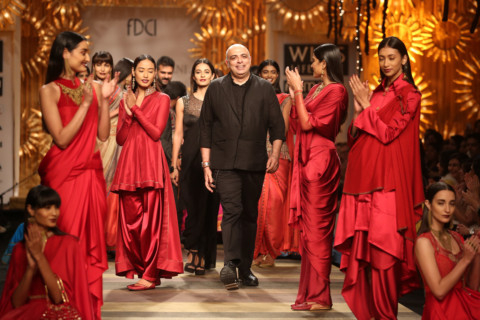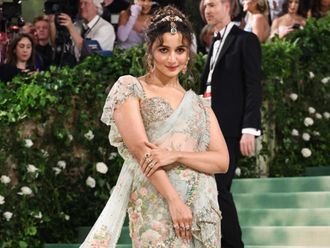
He was one of the few Indian designers whose name was recognised in the world in 1980s. But Tarun Tahiliani did not start out in the fashion industry. A business management graduate from Wharton Business School, University of Pennsylvania, Tahiliani joined the family business in oilfield equipment.
Designing had still not grown on him, it was still business when he opened Ensemble, the first multi-designer boutique in India in Mumbai, with his wife Sailaja and with the help of designer friend Rohit Khosla. The designing bug finally seems to have bit him in 1991 when he enrolled at Fashion Institute of Technology in New York. The rest, as they say, is history.
On Saturday, Tahiliani will exhibit a brand new collection in Dubai at Sopritti in Murooj Rotana Hotel.
“What I bring today is a derivative of a new line called TT.DIY which hasn’t been officially launched yet. I was told by Pritti [Nanda, the lady behind the sopritti brand] that this exhibition was more about lighter, easier wear,” Tahiliani told tabloid!
“So we are bringing a lot of separates in fun prints, colours and cuts — tunics, kaftans, dresses — that you can individualise. Everything is very light.”
In an earlier interview to a fashion magazine, Tahiliani said that this line is all about engaging with everyday life — which happens to be his basic philosophy of fashion — and is all about “permutations and combinations. Ideally, these pieces should stick around in your closet like a good Armani sweater from 20 years ago, something that gets better with more wear.”
The collection is said to include “dhoti pants, pleated jumpsuits, draped dupattas, peplum gilets, capes and capelets, roomy palazzos, luxe ombré cashmeres, crop tops that can double up as cholis and kalidar kurtas that can be worn as dresses. Made from jersey, crinkle-free handloom mixes and fine wool, Tahiliani said they are good to be worn by anyone from “18 to 70”.
“This is not a bridal collection at all,” he continued. “Another reason we are coming is to explore the possibility of opening a proper salon as, clearly, Dubai has become the centre of the Middle East. Every time I come here, I’m shocked to see the development and style with which they are doing things. Therefore people come from all over the world to shop here. Plus, it’s the gateway to the Middle East now. So as a designer it makes sense for me to be here because our lifestyle is similar, our client is similar, our love for colour is similar — and this is not just with Indian expatriates here but Arabs too.”
It’s not that Tahiliani did not retail in the city earlier but he says the downturn didn’t favour much, plus, now that his two sons are part of the business, there was a lot of reorganising happening within the company.
“We felt there was no point coming just with a bridal collection to Dubai. We do a lot of beautiful evening wear, which is very popular here because of its fine thread work and couture [quality]. But then it has to be done with an appropriate store. You can’t sell it, say, from one of the Jumeirah villas because the staff ... they don’t know how to sell. Now with Delhi and Dubai so well connected with multiple flights during the day, it’s so much easier. So let’s see.”
Excerpts from the interview:
Being one of the forerunners, in a way, in Indian fashion, you must have seen a lot of changes in the industry. Tell us about them.
There have been some very good changes and some disturbing ones. The good change is that there was no retail then. Then fashion weeks happened and they helped organise the industry and brought buyers in. So it took it to the next level. It made people stratify. Some people did sportswear, some did bridal. I do easy resort lines plus I do bridal.
The problem that I’ve been noticing of late is that for some reason, we are still a bit colonised because some people wear western clothes even when it’s not appropriate. That’s creating a problem because they are either trying to wear western clothes or be overtly Indian with these postures of Royal India. Both are absurd because neither suits them.
Your Lakme Fashion Week was inspired by Russian folklore. As you need to come up with something in all your shows and collections, tell us what inspires you.
You only work in this field because that’s what you live for. Last few nights I’ve been sleeping really late. I’ve been reading books, looking at things, doing research, how to make your mood work and translate that. Last year I worked with the Singh Twins, [British-Asian sisters who are artists working in Indian miniature tradition with modern art]. Next year I may work with another artist. This whole process of engagement and understanding by technique and how to apply your passion is super interesting to me. That sparks the lure of my job.
Also at the fashion show we saw designers bring the craftsmen and artists behind their collections to the ramp ...
It’s a great thing that designers are bringing these workers forward because, unfortunately in fashion, people want to buy a brand and they aren’t interested in where it’s coming from. All this time the artisan was neglected — and exploited in most cases. But it won’t really change things completely, even though it is a gesture of respect and encouragement towards them. The only thing is they should be paid fairly and encouraged and more importantly their children shouldn’t just migrate to the cities. They should want to learn the craft and take things to the next level.
With so many new designers on the ramp, who do you think one should look out for?
Definitely Rahul Mishra. I love what he does and his presentation is superb for someone so young. I think in labels, Rina Singh of Eka is very good. I like Amit Agarwal’s work. But there is so much talent here that it’s hard to keep up. They seem to be coming out of the woodwork. Plus they are so well educated they know what they are doing unlike us who learnt by falling on our faces. They are way ahead of the curve when we were their age.













